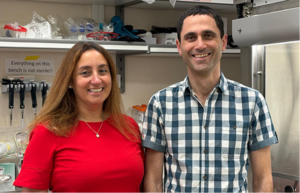BGU, Hebrew U.: Desert regions may better inform the future of global temperate zones driven by climate change

According to NASA, nineteen of the hottest years have occurred since 2000, with 2016 and 2020 tied for the hottest ever on record. This summer is already making worldwide headlines, with the UK reaching 40 degrees Celsius for the first time ever.
More climate extremes are occurring. Earlier snowmelts affect the high-altitude areas, severe forest fires are increasing, while rain pulses, followed by dry periods, are becoming the norm. But if heat waves and severe droughts are trends that will continue to hold across the globe, what will the future bring to the temperate forest and cropland regions of the world?
Scientists have been looking at the unique adaptations of desert life, which function by their own set of rules long considered to be unique to dry areas, for years. Now, new research published yesterday (Monday) by an international team of scientists suggests that climate change is causing these “dryland mechanisms” to increasingly affect Earth’s wetter areas, such as temperate regions’ croplands and forests.
To better predict how the world’s wetter areas will operate in the future, the scientific team recommends that we can begin to apply the lessons learned from how life works in arid regions, according to new research published in the journal Nature Ecology and Evolution. The study was led by Prof. José Grünzweig of The Hebrew University of Jerusalem, Israel and co-authored by Dr. Omer Tzuk and Prof. Ehud Meron of Ben-Gurion University of the Negev, among others.
The researchers state that their new insights can contribute to advancing the adaptive capacity to withstand climate extremes and lessen their impacts on nature and people.
Spurred by a recent meeting of the European Ecological Federation and an action of the European Cooperation in Science & Technology (COST), the team compiled a list of the unique rules of life driving dryland ecosystems. Currently, more than a third of the Earth’s land area is drylands. Many of these key processes have been considered relevant only to arid regions, including:
• rapid cycling between wet and dry conditions that influence plant and animal activity,
• redistribution of water in soils by plant roots,
• and formation of living crusts on soil surfaces by microscopic organisms.
Overall, the team identified a dozen different dryland mechanisms affecting multiple processes, including vegetation distribution, plant growth, water flow, energy budget, carbon and nutrient cycling, and decomposition of dead material. These dryland mechanisms are controlled by environmental factors, such as intense solar radiation, high temperatures, large bare patches between plants, and inconsistent availability of water.
The mechanisms were also categorized as either more likely to be fast-responding – those that we might expect to see occurring from short-term drought (e.g., dry-wet cycles, heat and sunlight breaking down dead material) and slow-responding – those that would happen after decades of dry conditions (e.g., formation of living crust on soils) as a result of changes in plant distribution.
The researchers presented these 12 dryland mechanisms that are routine processes in drylands but aren’t commonly found in wet systems. Then they categorized these mechanisms based on how likely it is that they are going to happen in wetter systems in the future. The researchers asked: what sort of changes would be required to start seeing those in wetter systems?
What’s clear to the researchers is that a new, unprecedented pattern is emerging, one that was considered absent or insignificant in most biomes on Earth. These dryland mechanisms are now, with increasing frequency, occurring in temperate regions. In the future, these also will likely increase in frequency and become more relevant due to warmer, drier conditions from climate change.
For example, much of Europe experienced a severe drought and heat wave in summer 2018. As a result, the low plant cover in agricultural fields during this time likely led to desert-like biological processes occurring in these usually wet locations (see Denmark summer 2018 image). And a new heat wave is also scorching Europe this summer. Under these conditions plant growth decreased dramatically in those systems, which leads to more exposure of bare soil on the surface that’s not covered by plants.
To better understand potential future ramifications of dryland mechanisms on things like vegetation distribution and decomposition of dead material, the team took its drylands’ data and modeled it to show how the forces driving drylands will increasingly apply to temperate regions under future climate conditions.
The results and long-term consequences were stunning. For example, their models predict that the total non-dryland area with average topsoil temperature of >40C is estimated to increase by about 17 million km2 (approximately equal to the total land area of the USA and Brazil) by the end of the century. Furthermore, moisture in the topsoil is expected to decrease in 74% of the global land area currently not classified as drylands.
The researchers note that mathematical models are commonly used to predict how systems will behave under drier or hotter conditions, but it is usually assumed that the operating rules will stay the same even if the climate changes. The researchers then asked: what if the rules by which the system works change and the established models don’t really take this into account?
Dry soil conditions will cause the emergence of many dryland mechanisms, such as redistribution of soil water via plant roots. Other mechanisms will respond to changes in vegetation, with more sparsely distributed vegetation increasing the prevalence of organisms forming soil surface crusts, and increasing the role of sunlight in breaking down dead leaves.
Clearly some of these projected changes will occur in regions with large human populations, and, thus, will significantly affect the well-being of society in these regions. The researchers note that they will need continued research on ecosystems under increasing frequency and severity of droughts and heat waves in order to improve their understanding of the underlying emergent processes.
Ultimately, the researchers hope that a better understanding of these uniquely adapted desert systems will lead society to set realistic expectations for the future of historically temperate and wetter areas before it’s too late to heed Mother Nature’s call.
Published in Nature Ecology and Evolution July 25th 2022







